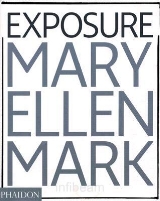Site created by Amplitude. |
||
Exposure review
Exposure, Mary Ellen Mark – Phaidon. £49.95
Larry Fink, Laurie Dahlberg – Phaidon. £14.95
Steve McCurry, Anthony Bannon – Phaidon. £14.95
Family: Photographers and their families – Phaidon. £24.95
Acclaimed American documentary photographer Mary Ellen Mark has been called the most influential woman photographer of all time. Exposure, a collection of 135 prints, brings together her most personal photographs from the past forty years, offering readers personal insights into the lives of those people often deemed to be on the fringes of society at home (the US) and abroad (principally India).
The book is a catalogue of often quirky, tragic-comic portraits of – among others – circus entertainers and dwarves, twins, travellers and children. There is a peculiar sadness about many of the shots selected, such as those of blind Ukrainian children picking flowers, or those of patients in a mental hospital in Oregon. Others capture a strange incongruity, such as the portrait of a white supremacist dozing with his baby daughter, or the picture of a boy supporting a pro-Viet Nam war demonstration with his mother, holding a sign that says: “If your heart is not in the USA get your ass out now”.
Mark’s photographs are involving because they show the quirks and sadness of ordinary people. Her photography is clearly intended to make people empathise with her subjects, and her work is the more powerful for that. For anyone interested in non-formal portraiture and street photography, this book is well worth a look.
Larry Fink is an introduction to the work of an American photographer known as the “Jack Kerouac of photography”. This is the first and only book to assess the entirety of Fink's 40-year career as a photographer, which mainly couples street photography with the kind of gentle wit typified by renowned Magnum photographer Elliot Erwitt. The book documents the development of Fink's photographs through 55 chronologically presented photographs, with an introductory text and picture-by-picture commentary by US art historian Laurie Dahlberg.
The result is a mess. Dahlberg’s entire commentary is fit for Private Eye’s “Pseud’s Corner”, a dumping ground for pretentious, trite nonsense. For example, a photograph of a smartly-dressed man walking out of a bar in Hanover Square in New York is labelled thus: “Although the viewer cannot know this man’s circumstances, in this context one nevertheless concludes that the man’s intense capitalist drive has left him unsettled and bitter.” How so?
Fink’s photographs also do not come up to scratch. The selection of prints shows little flair, and his reliance on full flash to freeze subjects looks particularly amateurish, especially since it produces strong shadow.
Phaidon’s new introduction to the work of Steve McCurry is a million times better. McCurry is best known for his stunning colour photography and portraits from India and other parts of Asia. His shot of a green-eyed Afghan girl taken in Peshawar, Pakistan, back in 1984 has become iconic: it was also voted National Geographic magazine’s best picture. All the photographs selected for this edition are perfect compositions and the book is a must for anyone interested in appreciating the natural beauty of Asia and colour travel photography.
In Family, photographers turn the lens inwards for a change and we see intimate and charming pictures of wives, children and homes. The result is a diverse and rich selection of 175 photographs and intimate moments compiled by Sophie Spencer-Wood.
“For anyone interested in non-formal portraiture and street photography, this book is well worth a look”




